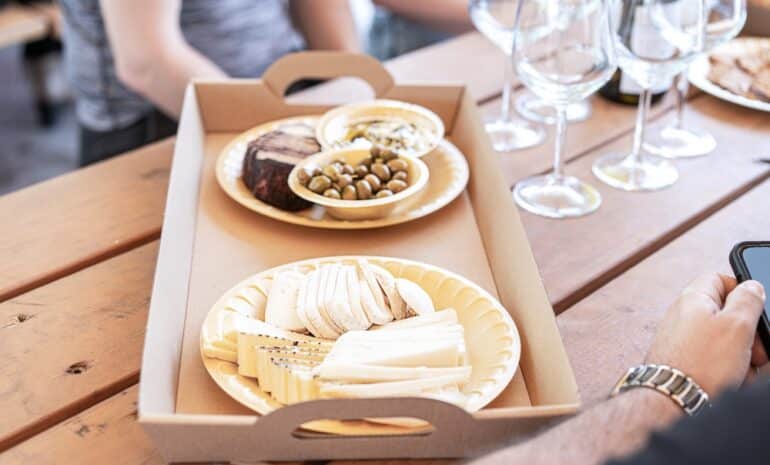Restaurant owners often invest in ads, email, SMS, loyalty programs, social media, and other restaurant marketing channels without clarity on which ones deliver meaningful returns. With limited budget and time, every dollar counts. That is why marketing ROI analysis matters more than ever. Knowing which channel brings in more diners, at what cost, and over what timeframe, gives you control.
Our team at Dineline uses Dineline analytics to help restaurant owners make data‑driven decisions rather than guessing or following trends. If you feel overwhelmed by choices like Google ads versus email blasts or loyalty rewards, then you are in luck. We are here to help you focus on the most effective restaurant marketing channels for your goals.
Top Channels Used by Restaurants
Four main growth vehicles dominate restaurant marketing:
- Paid ads, including Google Search, Facebook, and Instagram ads
- SMS messaging for promotions and time‑sensitive offers
- Email campaigns to nurture your customer base over time
- Loyalty or membership programs to drive repeat visits
These restaurant marketing channels each have pros and cons. Paid ads offer scale and targeting options, but can be costly and fade when you stop. SMS is fast and direct, but requires careful compliance. Email builds long‑term relationships but requires strong content. Loyalty programs boost average check value but take time to launch effectively. Deciding which restaurant marketing channels to prioritize depends on your goals and audience. However, all of these channels require marketing ROI analysis to compare performance. Without tracking spend versus revenue per channel, you’re flying blind.
How to Measure and Compare Their Impact
Measuring performance across different restaurant marketing channels can feel complex because each channel has its own dynamics. That is why clear marketing ROI analysis frameworks are essential. Here are some key steps to follow:
Set Consistent Metrics
Choose metrics like cost per new customer, return on ad spend (ROAS), average order value, campaign cost, and repeat rate across channels.
Implement Proper Tracking
Use trackable links, promo codes, QR codes, or landing pages for each channel. This lets you attribute orders to specific campaigns.
Collect Cost Data
Record your spend on each channel, including ad budget, SMS message costs, email platform fees, and loyalty program costs.
Track Revenue
Connect your sales data to channel attribution. How much revenue did each customer generate, and were they new or returning?
Calculate ROI
Use simple ROI formulas to compare channels: Revenue minus cost divided by cost.
Compare Performance
Plot each channel on a chart to see which restaurant marketing channels outperform others in terms of cost and net return. Use weekly or monthly time frames to monitor trends.
Pivot Spending
If one channel shows higher ROI, reallocate the budget accordingly. For example, a restaurant owner might shift 20 percent of ad spend to SMS if those texts generate more profitable orders. This kind of marketing ROI analysis empowers faster growth.
Many restaurants skip these steps because they seem too technical. Without attribution data, you rely on gut feel instead of facts. Worse, you might scale low-performing restaurant marketing channels for years while high-potential channels languish. That is why clear marketing ROI analysis is a competitive advantage.
How Dineline Simplifies Channel Attribution
Our team at Dineline uses Dineline analytics to answer the question, “Which channel really drove my business?” We designed our platform to handle the complexity for you. Here is how we simplify your marketing ROI analysis:
- Unified Dashboard attribution: We integrate with ad platforms, SMS tools, email providers, and your POS. Every marketing touchpoint is tracked in one Dineline analytics dashboard. You can view orders, revenue, new versus repeat customers, and profitability by each restaurant marketing channel.
- Automated ROI computation: Stop doing manual spreadsheets. Dineline automatically calculates ROI for each channel. You see net returns, costs, ROAS, and cost‑per‑acquisition in charts and tables.
- Granular campaign insights: Dig deeper at the campaign level. Compare a summer promotion SMS versus a holiday loyalty email. Our platform shows which had a higher ROI, helping you reallocate resources accordingly
- Real‑time comparisons: No more lag. With Dineline analytics you can compare daily or weekly performance across restaurant marketing channels in real time. That agility lets you pivot quickly.
- Customizable channel weightings: Use filters to include only new customer orders or orders over a certain value. That helps you compare channels based on strategic goals, not just raw volume.
- Alerts when ROI dips: Our system flags if a campaign’s ROI falls below your threshold. It could indicate fatigue, creative burnout, or audience saturation with that restaurant marketing channel.
- Workflow automation: See a channel performing well? Our team can help you automate budget shift rules so the system increases spend on high ROI channels and pauses low ROI ones.
Using Dineline analytics means you stop guessing and start scaling smarter. With this level of clarity, you can confidently invest more in channels that outperform, not just those that feel trendy or promise quick wins. Our platform turns marketing ROI analysis into a competitive advantage. That is how data-driven restaurants win more customers and grow profitably.
Case Examples of Pivoting Spend Based on Data
Real restaurant success is built on informed decisions. With Dineline analytics, our clients don’t have to guess which marketing channels are working. They can clearly see the impact of each campaign and pivot their efforts with confidence. Here are two standout examples of how data-driven decisions led to measurable growth.
Michale and Alysha, owners of Wild Owl, saw a dramatic shift in their performance after partnering with our team. “Dineline has been a game-changer for our restaurant, Wild Owl. In just a month, our sales skyrocketed by 98% year over year,” they shared. By leveraging Dineline analytics, we identified which restaurant marketing channels were driving the highest returns. With consistent adjustments guided by real-time data and ongoing support from our team, they maintained a steady 55 to 60 percent increase in performance. Michale and Alysha credit efficient communication, clear explanations, and comprehensive reporting for making Dineline a trusted partner in their growth.
Ben from BORO Market also saw extraordinary results from reallocating his marketing spend. “Since partnering with Dineline, BORO Market has experienced remarkable growth,” he said. Within just two months, customer traffic and revenue surged. December alone brought a 58% increase over previous periods, with January following at 59%. Using Dineline analytics, Ben was able to optimize his online presence and confidently adjust spend toward the most effective restaurant marketing channels. This allowed him to focus more on daily operations while knowing his marketing was working harder for him.
These examples prove the power of marketing ROI analysis. With the right data and support, you can make smarter decisions that drive real business growth.
Contact Our Team Today
Not every marketing channel deserves an equal budget. Ads may drive reach, SMS may drive fast conversions, email builds relationships, and loyalty pushes repeat visits. The key is using proper marketing ROI analysis to know which channel delivers the best return for your unique restaurant. With those insights in hand, our team at Dineline makes channel attribution and pivoting spending simple through Dineline analytics. If you are unsure which restaurant marketing channels are your most effective, let Dineline show you.
Unsure which channel wins? Let Dineline show you.


